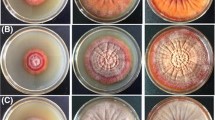Abstract
The fluence response of the blue light induced carotenoid synthesis inNeurospora is biphasic. Using fluence rates between 0.3 and 40 Wm-2, increasing illumination times beyond 16 min (at 20°C) result in a second rise of the amount of carotenoids synthesized in the subsequent dark period. On altering the temperature, the transition point to the second phase of the response is shifted to shorter/longer illumination periods with increasing/decreasing temperature, respectively. The transition point can also be shifted by administering high fluence rates of near UV light: The start of the second phase is already triggered after an irradiation time of 2 min. The findings suggest that elements of the transduction sequence become depleted and senstivity recovers in a temperature-dependent process. The biphasic response and the effects of UV light are discussed in relation to the transduction mechanism and to the ecological significance.
Similar content being viewed by others
References
Blaauw, O.H., Blaauw-Jansen G., van Leeuwen, W.J. (1968) An irreversible red-light-induced growth response inAvena. Planta82, 87–104
Blaauw-Jansen, G. (1974) Dose response curves for phytochrome-mediated anthocyanin synthesis in the mustard seedling (Sinapis alba L.). Acta Bot. Neerl.23, 513–519
Bradford, S.W., Gibgot, B.J. (1963) Rapid production ofNeurospora hyphae. Neurospora Newsletters4, 17–19
Bunsen, R., Roscoe, H. (1862) Photochemische Untersuchugen. Ann. Phys. Chem.117, 529–562
De Fabo, E.C., Harding, R.W., Shropshire, W. Jr. (1976) Action spectrum between 260 and 800 nanometers for the photoinduction of carotenoid biosynthesis inNeurospora crassa. Plant Physiol.57, 440–445
Du Buy, H.G., Nuernbergk, E. (1934) Phototropismus und Wachstum der Pflanzen. II. Ergeb. Biol.10, 207–322
Frost, L.C. (1962) Conidiating media forNeurospora. Neurospora Newsletters1, 11
Harding, R.W. (1974) The effect of temperature on photo-induced carotenoid biosynthesis inNeurospora crassa. Plant Physiol.54, 142–147
Haupt, W. (1958) Über den Primärvorgang bei der polarisierenden Wirkung des Lichts auf keimendeEquisetum-Sporen. Planta51, 74–83
Haupt, W., Meyer zu Bentrup, F.-W. (1961) Versuche zur Polaritätsinduktion durch Licht beiEquisetum-Sporen undFucus-Zygoten. Naturwissenschaften23, 723
Hertel, R. (in press) Phototropism in lower plants. In: Photoreception and sensory transduction in aneural organisms, Lenci, F., Colombetti, G., eds. Plenum, Press, New York London
Huber, A., Schrott, E.L. (in press) Photokilling and protective mechanisms inFusarium aquaeductuum. In: The blue light syndrome, Senger, H., ed. Springer, Berlin Heidelberg New York
Jayaram, M., Presti, D., Delbrück, M. (1979) Light-induced carotene synthesis inPhycomyces. Exp. Mycol.3, 42–52
Lipson, E.D. (1975) White noise analysis ofPhycomyces light growth response system. II. Extended intensity ranges. Biophys. J.15, 1013–1031
Murillo, F.J., Calderón, L.L., Lópes-Diaz, I., Cerdá-Olmedo, E. (1978) Carotene-superproducing strans ofPhycomyces. Appl. Environm. Microbiol.36, 639–642
Rau, W. (1962) Über den Einfluß der Temperatur auf die lichtabhängige Carotinoidbildung vonFusarium aquaeductuum. Planta59, 123–137
Rau, W. (1967) Untersuchungen über die lichtabhängige Carotinoidsynthese. I. Das Wirkungsspektrum vonFusarium aquaeductuum. Planta72, 14–28
Rau, W., Lindemann, I., Rau-Hund, A. (1968) Untersuchungen über die lichtabhängige Carotinoidsynthese. III. Die Farbstoffbildung vonNeurospora crassa in Submerkskultur. Planta80, 309–316
Russo, V.E.A. (in press) Sensory transduction in phototropism: Genetic and physiological analysis inPhycomyces. In: Photoreception and sensory transduction in aneural organisms, Lenci, F., Colombetti, G., eds. Plenum Press, New York London
Schrott, E.L. (1969) Wachstumsbedingungen für Submerskultur und lichtabhängige Carotinoidsynthese vonFusarium oxysporum. Diplomarbeit, Universität München
Theimer, R.R. (1968) Untersuchungen zum Wirkungsmechanismus von Licht und Mercuribenzoat bei der Carotinoidsynthese inFusarium aquaeductuum. Ph. D. Thesis, Universität München
Theimer, R.R., Rau, W. (1969) Mutants ofFusarium aquaeductuum lacking photoregulation of carotenoid synthesis. Biochim. Biophys. Acta177, 180–181
Vanderhoef, L.N., Briggs, W.R. (1977) Kinetic and spectral studies on red light-induced suppression of mesocotyl elongation in maize. Carnegie Inst. Wash. Year Book76, 283–286
Zalokar, M. (1955) Biosynthesis of carotenoids inNeurospora. Action spectrum of photoactivation. Arch. Biochem.56, 318–325
Zimmermann, B.K., Briggs, W.R. (1963) Phototropic dosage-response curves for oat coleoptiles. Plant Physiol.38, 248–253
Author information
Authors and Affiliations
Rights and permissions
About this article
Cite this article
Schrott, E.L. Fluence response relationship of carotenogenesis inNeurospora crassa . Planta 150, 174–179 (1980). https://doi.org/10.1007/BF00582363
Received:
Accepted:
Issue Date:
DOI: https://doi.org/10.1007/BF00582363




